Related Research Articles
E-commerce is the activity of electronically buying or selling products on online services or over the Internet. E-commerce draws on technologies such as mobile commerce, electronic funds transfer, supply chain management, Internet marketing, online transaction processing, electronic data interchange (EDI), inventory management systems, and automated data collection systems. E-commerce is the largest sector of the electronics industry and is in turn driven by the technological advances of the semiconductor industry.
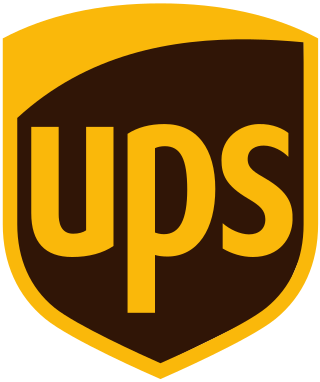
United Parcel Service, Inc. (UPS) is an American multinational shipping & receiving and supply chain management company founded in 1907. Originally known as the American Messenger Company specializing in telegraphs, UPS has grown to become a Fortune 500 company and one of the world's largest shipping couriers. UPS today is primarily known for its ground shipping services as well as the UPS Store, a retail chain which assists UPS shipments and provides tools for small businesses. UPS offers air shipping on an overnight or two-day basis and delivers to post office boxes through UPS Mail Innovations and UPS SurePost, two services that pass on packages to the United States Postal Service for last-mile delivery.
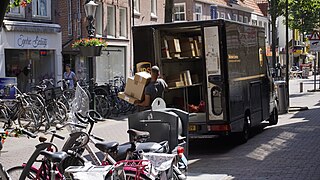
Package delivery or parcel delivery is the delivery of shipping containers, parcels, or high value mail as single shipments. The service is provided by most postal systems, express mail, private courier companies, and less than truckload shipping carriers. Package delivery is different in each country, and how packages are delivered is closely connected with the cost for delivering to that country as well as population. In 2019, China, The United States, and Japan were the leaders in package delivery while Latvia, Macau, and Iceland were the bottom three. The population of the bottom three barely totals 2 million while the population of the top three tops totals more than 2 billion. Package delivery is an every day occurrence in the USA while many other countries do not have this luxury.

Black Friday is the Friday after Thanksgiving in the United States. It traditionally marks the start of the Christmas shopping season in the United States. Many stores offer highly promoted sales at discounted prices and often open early, sometimes as early as midnight or even on Thanksgiving. Some stores' sales continue to Monday or for a week.

In transportation, freight refers to goods conveyed by land, water or air, while cargo refers specifically to freight when conveyed via water or air. In economics, freight refers to goods transported at a freight rate for commercial gain. The term cargo is also used in case of goods in the cold-chain, because the perishable inventory is always in transit towards a final end-use, even when it is held in cold storage or other similar climate-controlled facilities, including warehouses.

A courier is a person or organization that delivers a message, package or letter from one place or person to another place or person. Typically, a courier provides their courier service on a commercial contract basis; however, some couriers are government or state agency employees.
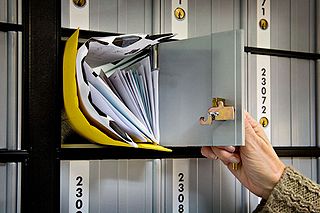
A post office box is a uniquely addressable lockable box located on the premises of a post office.

Border trade, in general, refers to the flow of goods and services across the border between different jurisdictions. In this sense, border trade is a part of the normal trade that flows through the ordinary export/import legal and logistical frameworks of nations and smaller jurisdictions. However border trade specifically refers to the increase in trade in areas where crossing borders is relatively easy and where products are significantly less expensive on one side of the border than the other – often because of significant variations in taxation levels on goods. Common items involved in border trade include alcohol, tobacco, medication, recreational drugs, automobiles, automotive fuel, groceries, furniture and clothing.

Online shopping is a form of electronic commerce which allows consumers to directly buy goods or services from a seller over the Internet using a web browser or a mobile app. Consumers find a product of interest by visiting the website of the retailer directly or by searching among alternative vendors using a shopping search engine, which displays the same product's availability and pricing at different e-retailers. As of 2020, customers can shop online using a range of different computers and devices, including desktop computers, laptops, tablet computers and smartphones.

A receipt is a document acknowledging that a person has received money or property in payment following a sale or other transfer of goods or provision of a service. All receipts must have the date of purchase on them. If the recipient of the payment is legally required to collect sales tax or VAT from the customer, the amount would be added to the receipt, and the collection would be deemed to have been on behalf of the relevant tax authority. In many countries, a retailer is required to include the sales tax or VAT in the displayed price of goods sold, from which the tax amount would be calculated at the point of sale and remitted to the tax authorities in due course. Similarly, amounts may be deducted from amounts payable, as in the case of taxes withheld from wages. On the other hand, tips or other gratuities that are given by a customer, for example in a restaurant, would not form part of the payment amount or appear on the receipt.
Drop shipping is a form of retail business in which the seller accepts customer orders without keeping stock on hand. Instead, in a form of supply chain management, the seller transfers the orders and their shipment details either to the manufacturer, a wholesaler, another retailer, or a fulfillment house, which then ships the goods directly to the customer.
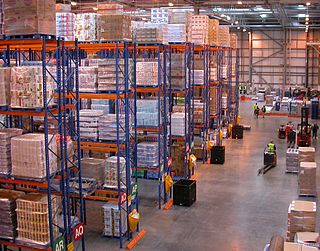
A distribution center for a set of products is a warehouse or other specialized building, often with refrigeration or air conditioning, which is stocked with products (goods) to be redistributed to retailers, to wholesalers, or directly to consumers. A distribution center is a principal part, the order processing element, of the entire order fulfillment process. Distribution centers are usually thought of as being demand driven. A distribution center can also be called a warehouse, a DC, a fulfillment center, a cross-dock facility, a bulk break center, and a package handling center. The name by which the distribution center is known is commonly based on the purpose of the operation. For example, a "retail distribution center" normally distributes goods to retail stores, an "order fulfillment center" commonly distributes goods directly to consumers, and a cross-dock facility stores little or no product but distributes goods to other destinations.

Mail order is the buying of goods or services by mail delivery. The buyer places an order for the desired products with the merchant through some remote methods such as:
Post offices and other mail service providers typically offer a mail forwarding service, commonly known as hybrid mail or virtual post office box services, to redirect mail addressed to one location to another address – usually for a given period. In the case of the United States Postal Service's First Class Mail, it is generally for a period of one year. British Royal Mail provides a service called Mail Redirection, enabling redirection for up to two years. Customers of such a service usually, but not exclusively, use mail forwarding when they change an address.

Brick and mortar is an organization or business with a physical presence in a building or other structure. The term brick-and-mortar business is often used to refer to a company that possesses or leases retail shops, factory production facilities, or warehouses for its operations. More specifically, in the jargon of e-commerce businesses in the 2000s, brick-and-mortar businesses are companies that have a physical presence and offer face-to-face customer experiences.
Free shipping is a marketing tactic used primarily by online vendors and mail-order catalogs as a sales strategy to attract customers.
An online grocer is a supermarket or grocery store that allows ordering via websites or mobile apps. The order can either be collected by the customer or delivered to the customer by drivers engaged by the grocer, a food delivery service, or by delivery drones and robots.
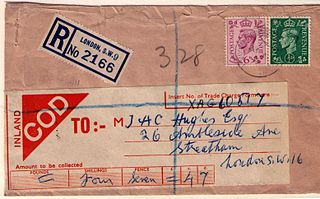
Cash on delivery (COD), sometimes called payment on delivery, cash on demand, payment on demand or collect on delivery is the sale of goods by mail order where payment is made on delivery rather than in advance. If the goods are not paid for, they are returned to the retailer. Originally, the term applied only to payment by cash but as other forms of payment have become more common, the word "cash" has sometimes been replaced with the word "collect" to include transactions by checks, money orders, credit cards or debit cards.
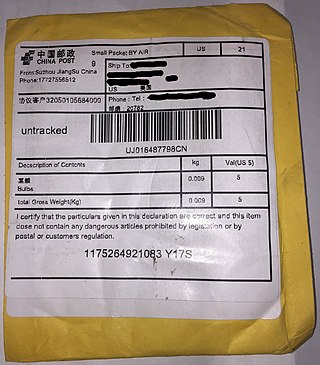
In e-commerce, brushing, also called "review brushing", is a deceitful technique sometimes used in e-commerce to boost a seller's ratings by creating fake orders, which are either shipped to an accomplice or to an unsuspecting member of the public.

A package redirection scam is a form of e-commerce fraud, where a malicious actor manipulates a shipping label, to trick the mail carrier into delivering the package to the wrong address. This is usually done through product returns to make the merchant believe that they mishandled the return package, and thus provide a refund without the item being returned. It can also be done by the seller, generally by creating fraudulent online stores or creating fake listings on sites such as eBay or Mercari. This makes it very hard to perform a chargeback, as the tracking shows the item has been delivered. This is also known as an FTID scam, standing for Fake Tracking ID. When this scam is successful, the tracking number will show that the package has been delivered to the correct address, when the package was instead delivered to a different address. This package is generally empty or filled with garbage. However, this scam has mostly been “patched” via new technology provided by the various couriers globally. It is estimated the scam cost retailers £18,000,000,000 in lost revenue.
References
- ↑ Reilly, Claire (7 November 2014). "Package forwarding from the US to Australia: A complete guide". CNET. Retrieved 13 January 2015.
